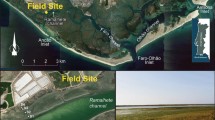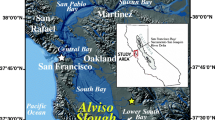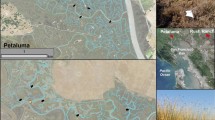Abstract
Tidal freshwater marshes are critical buffers that exist at the interface between watersheds and estuaries. Little is known about the physical dynamics of tidal freshwater marsh evolution. Over a 21-mo period, July 1995 to March 1997, measurements were made of biweekly sediment deposition at 23 locations in a 3.8-ha tidal freshwater marsh in the Bush River subestuary of the upper Chesapeake Bay. Biweekly accumulation showed high spatial and temporal variability, ranging from −0.28 g cm−2 to 1.15 g cm−2. Spatial variability is accounted for by habitat differences including plant associations, elevation, and hydrology. Temporal variability is accounted for by interannual climate variability, the growth cycles of marsh plants, stream-marsh interactions, forest-marsh interactions, and animal activity.
Similar content being viewed by others
Literature Cited
Brush, G. S. 1984. Patterns of recent sediment accumulation in Chesapeake Bay (Virginia-Maryland, U.S.A.) tributaries.Chemical Geology 44:227–242.
Brush, G. S. 1989. Rates and patterns of estuarine sediment accumulation.Limnology and Oceanography 34:1235–1246.
Defries, R. S. 1986. Effects of land-use history on sedimentation in the Potomac Estuary, Maryland. United States Geological Survey Water Supply Paper 2234-K. Washington, D.C.
Doornkamp, J. C. andC. A. M. King. 1971. Numerical Analysis in Geomorphology: An Introduction. Arnold, London.
Dubinski, B. J., R. L. Simpson, andR. E. Good. 1986. The retention of heavy metals in sewage sludge applied to a freshwater tidal wetland.Estuaries 9:102–111.
Findlay, S., K. Howe, andH. K. Austin. 1990. Comparison of detritus dynamics in two tidal freshwater wetlands.Ecology 71: 288–295.
Freund, J. E. andG. A. Simon. 1991. Statistics: A First Course, 5th ed. Prentice Hall, Englewood Cliffs, New York.
Gottschalk, L. C. 1945. Effects of soil erosion on navigation in upper Chesapeake Bay.Geographical Review 35:219–238.
Hilgartner, W. B. 1995. Habitat development in a freshwater tidal wetland: A paleoecological study of human and natural influences. Ph.D. Dissertation, Johns Hopkins University, Baltimore, Maryland.
Hupp, C. R. andD. E. Bazemore. 1993. Temporal and spatial patterns of wetland sedimentation, West Tennessee.Journal of Hydrology 141:179–196.
Jordan, T. E., J. W. Pierce, andD. L. Correll. 1986. Flux of particulate matter in the tidal marshes and subtidal shallows of the Rhode River Estuary.Estuaries 9:310–319.
Khan, H. andG. S. Brush. 1994. Nutrient and metal accumulation in a freshwater tidal marsh.Estuaries 17:345–360.
Marcus, W. A. andM. S. Kearney. 1991. Upland and coastal sediment sources in a Chesapeake Bay estuary.Annuls of the Association of American Geographers 81:408–424.
Miller, R. L. andJ. S. Kahn. 1962. Statistical Analysis in the Geological Sciences. Wiley, New York.
Odum, W. E. 1988. Comparative ecology of tidal freshwater and salt mashes.Annual Review of Ecological Systems 19:147–176.
Orson, R. A., R. L. Simpson, andR. E. Good. 1990. Rates of sediment accumulation in a tidal freshwater marsh.Journal of Sedimentary Petrology 60:859–869.
Orson, R. A., R. L. Simpson, andR. E. Good. 1992. The paleoecological development of a late Holocene, tidal freshwater marsh of the upper Delaware River estuary.Estuaries 15:130–146.
Reyment, R. A. 1971. Introduction to Quantitative Palaeoecology. Elsevier, Amsterdam.
Reed, D. J. 1989. Patterns of sediment deposition in subsiding coastal salt marshes, Terrebonne Bay, Louisiana: The role of winter storms.Estuaries 12:222–227.
Roberts, W. P. andJ. W. Pierce. 1976. Deposition in Upper Patuxent Estuary, Maryland, 1968–1969.Estuarine and Coastal Marine Science 4:267–280.
Rozas, L. P. andW. E. Odum. 1987. Use of tidal freshwater marshes by fishes and macrofaunal crustaceans along a marsh stream-order gradient.Estuaries 10:36–43.
Serodes, B. andP. Troude. 1984. Sedimentation cycle of a freshwater tidal flat in the St. Lawrence Estuary.Estuaries 7:119–127.
Simpson, R. L., R. E. Good, R. A. Leck, andD. F. Whigham. 1983a. The ecology of freshwater tidal wetlands.Bioscience 33:255–259.
Simpson, R. L., R. E. Good, R. Walker, andB. R. Frasco. 1983b. The role of Delaware River freshwater tidal wetlands in the retention of nutrients and heavy metals.Journal of Environmental Quality 12:41–48.
Till, R. 1974. Statistical Methods for the Earth Scientist: An Introduction. John Wiley and Sons, New York.
Whigham, D. F., R. L. Simpson, R. E. Good, andF. A. Sickels. 1989. Decomposition and nutrient-metal dynamics of litter in freshwater tidal wetlands, p. 167–188.In R. R. Sharitz and J. W. Gibbons (eds.), Freshwater Wetlands and Wildlife. United States Department of Energy, Office of Scientific and Technical Information, Oak Ridge, Tennessee.
Wolaver, T. G., J. C. Zieman, R. Wetzel, andK. L. Webb. 1983. Tidal exchange of nitrogen and phosphorus between a mesohaline vegetated marsh and the surrounding estuary in the Lower Chesapeake Bay.Estuarine, Coastal and Shelf Science 16:321–332.
Author information
Authors and Affiliations
Corresponding author
Rights and permissions
About this article
Cite this article
Pasternack, G.B., Brush, G.S. Sedimentation cycles in a river-mouth tidal freshwater marsh. Estuaries 21, 407–415 (1998). https://doi.org/10.2307/1352839
Received:
Accepted:
Issue Date:
DOI: https://doi.org/10.2307/1352839




